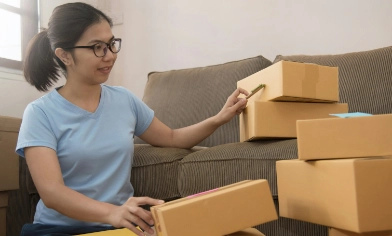Returns happen, so be ready
Customers sometimes change their minds. Items may arrive damaged or don’t fit. And other times people buy something expecting one thing but get another.
That’s where having a clear returns policy can make a big difference. It helps you and your customers know exactly where you stand and what to do next.
In this guide, we’ll explain why a good returns policy is so important and what it should say. Plus, how Post Office can help you handle returns in a way that keeps everyone happy.
Why a straightforward returns policy matters
When people shop in a real store, they can see and touch the item before buying it. They can try on clothes, feel the texture or ask questions face to face. But when shopping online, it’s harder to be sure that something is right until it arrives.
That’s why returns are a normal part of online shopping. And it’s why you need to be clear and honest about how you handle them.
Here’s how a good returns policy helps.
- It builds trust: People are more likely to buy from your shop if they know they can return something easily if it’s not right
- It encourages repeat customers: When someone has a smooth experience returning something, they’re more likely to come back and shop again
- It reduces problems: Clear rules mean fewer arguments or confusion when someone wants to return an item
Even if you rarely get returns, having a proper policy shows you care about your customers.
If you sell online, there are also rules you must follow. In most cases, customers have 14 days to change their mind and cancel an order. Once they send the item back, you have 14 days to give them a full refund, including the basic delivery cost.
Read the full rules on returns and refunds on GOV.UK
Returns for different types of items
Some items need special rules when it comes to returns. Here are a few examples:
- New items: These can usually be sent back if the customer changes their mind. Just make sure they haven’t been used and are still in their original packaging. This is common when selling on Amazon Marketplace or other large platforms
- Locally made items: If something is handmade or made just for the customer, you might not accept returns. Or you might only offer part of the money back. Be clear about this if you’re selling through your own site or popular seller platforms
- Preloved items: These are second-hand things. If you’re selling on eBay or pre-loved items on Vinted, you could offer a swap or a voucher instead of a full refund
Be clear about this in your returns policy so customers know what to expect.
How to write a returns policy for your online store
Your returns policy should be easy to read and understand. Try to keep it short, simple and polite. You don’t want your customers feeling confused or frustrated.
Here are the key things to include:
- Do you accept returns? If so, say yes clearly
- How long do they have? 14 or 30 days from the date the item arrives is common
- What condition must the item be in? For instance, unused and in its original packaging
- Who pays for postage? Will you cover the cost or does the customer pay to send it back?
- How do customers send it back? Will you give them a return label or a QR code?
- When will they get a refund or replacement? Let people know what to expect
Being clear about these points can save you a lot of time dealing with customer questions or complaints.
Top tip
If you sell on platforms like eBay, Etsy or Amazon, you can set up how you handle returns in your account settings. Some websites even let you make the process automatic, so return labels and refunds happen by themselves. This saves you a lot of time and work, especially if you sell often.
How returns usually work
When a customer wants to return something, they’ll usually follow steps like these.
- Let you know they want to return it, either by contacting you directly or creating a return automatically with you
- Package up the item carefully, so it doesn’t get damaged on the way back
- Attach a label (or they can show a QR code when dropping it off to print the label in-store)
- Drop off the parcel, for instance at a Post Office branch
- You’ll receive it and process the refund or send a replacement
The easier you make this process, the better your customers will feel. You can include return instructions in your original parcel or on your website to make things clearer.
How Post Office makes returns hassle-free
We can help your customers return items easily, and you build a strong reputation as a seller.
With over 11,500 branches, most people in the UK can find one nearby. Many branches are open early and late, including weekends, so your customers can drop off parcels at a time that suits them.
We offer lots of returns options too. Royal Mail and Parcelforce Worldwide services are available in all branches. And DPD, Evri and Amazon returns are offered in a growing number. Use our branch finder to check where you can return with these couriers.
Every return comes with proof of postage and tracking, so both you and your customers can see where the parcel is. Plus, if your customer doesn’t have a printer, many branches can print the return label from a QR code. All they have to do is show the code on their phone.
What you can do with returned items
Not everything that’s returned need go to waste. Many sellers find ways to turn returned items into future sales or useful materials.
Once you get items back, you’ve got a few choices for what to do next:
- Resell it at full price if it’s still in perfect condition and hasn’t been used
- Offer it in a seasonal or clearance sale (eg, if the packaging’s damaged or it’s been opened)
- Use parts from the item to fix or refurbish other items
- Donate or recycle items that can’t be sold again
Key takeaways
- A clear returns policy helps build trust and keeps your customers happy
- Always explain your return terms in simple words so everyone's clear
- Post Office offers easy, reliable returns with a range of couriers
- Returned items can often be reused or resold, so they’re not always a loss

















